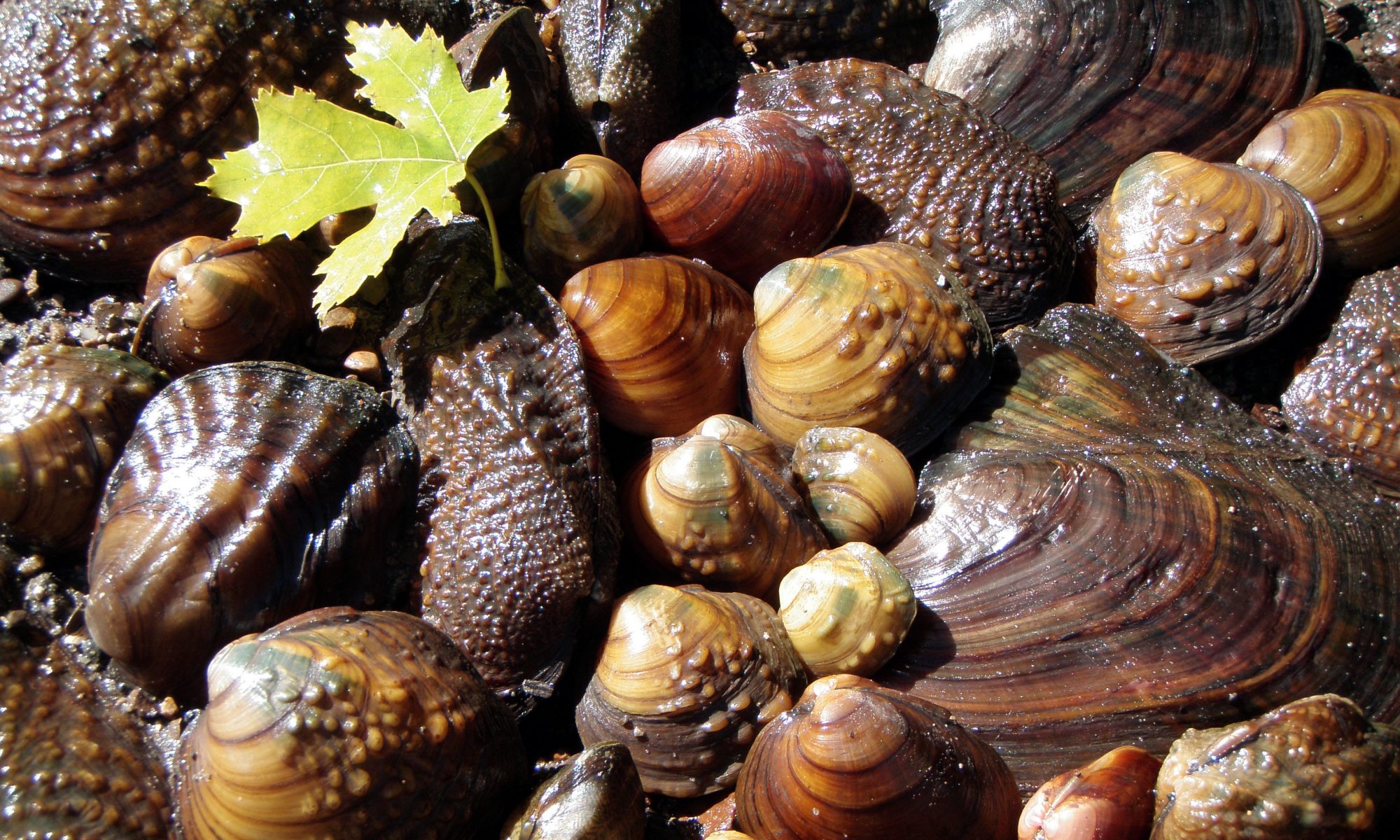Subfamily Cumberlandinae
Shell elongated, thin to moderately thick. Beak sculpture concentric. Surface of the shell dark brown to black. Pseudocardinal and lateral teeth poorly developed; present only as a thickened ridge. Sexual differences in the shell indistinct. Found in areas of reduced flow (around large boulders) in large rivers with swift currents.
Subfamily Ambleminae
Shell usually thick and solid. Beak sculpture generally indistinct. Surface of the shell brown, chestnut, or tan, rays or bands greatly reduced or absent. Pseudocardinal and lateral teeth usually well developed. Sexual differences in the shell indistinct. Most often found in streams, but occasionally present in lakes or large impoundments.
- Washboard, Megalonaias nervosa
- Pistolgrip, Tritogonia verrucosa
- Winged mapleleaf, Quadrula fragosa
- Mapleleaf, Quadrula quadrula
- Rabbitsfoot, Quadrula cylindrica
- Monkeyface, Quadrula metanevra
- Wartyback, Quadrula nodulata
- Pimpleback, Quadrula pustulosa
- Threeridge, Amblema plicata
- Ebonyshell, Fusconaia ebena
- Long-solid, Fusconaia subrotunda
- Wabash pigtoe, Fusconaia flava
- Purple wartyback, Cyclonaias tuberculata
- Sheepnose, Plethobasus cyphyus
- White wartyback, Plethobasus cicatricosus
- Orange-foot pimpleback, Plethobasus cooperianus
- Clubshell, Pleurobema clava
- Round pigtoe, Pleurobema sintoxia (=P. coccineum)
- Rough pigtoe, Pleurobema plenum
- Ohio pigtoe, Pleurobema cordatum
- Pyramid pigtoe, Pleurobema rubrum
- Elephant-ear, Elliptio crassidens
- Spike, Elliptio dilatata
- Cracking pearlymussel, Hemistena lata
- Pondhorn, Uniomerus tetralasmus
Subfamily Anodontinae
Shell thin, more or less elongated. Beak sculpture usually double-looped, occasionally concentric. Surface of the shell green, greenish brown, or black with or without fine green rays. Pseudo- cardinal and lateral teeth absent, reduced, or poorly developed. Sexual differences in the shell indistinct. Found in ponds, lakes, or the quiet-water areas of streams.
- Paper pondshell, Utterbackia (=Anodonta) imbecillis
- Flat floater, Anodonta suborbiculata
- Giant floater, Pyganodon (=Anodonta) grandis
- Cylindrical papershell, Anodontoides ferussacianus
- Creeper, Strophitus undulatus
- Elktoe Alasmidonta marginata
- Slippershell mussel, Alasmidonta viridis
- Rock-pocketbook, Arcidens confragosus
- Salamander mussel, Simpsonaias ambigua
- White heelsplitter, Lasmigona complanata
- Fluted-shell, Lasmigona costata
- Creek heelsplitter, Lasmigona compressa
Subfamily Lampsilinae
Shell relatively thin to moderately thick, rounded or oval to elongate. Beak sculpture generally double-looped but often indistinct. Surface of the shell mostly light yellow or tan with brightly colored rays or bands. Pseudocardinal and lateral teeth usually well-developed. Sexual differences in the shell apparent–squared or truncated posteriorly in females, bluntly pointed posteriorly in males. Found in streams, occasionally in lakes or other impoundments.
- Kidneyshell, Ptychobranchus fasciolaris
- Threehorn wartyback, Obliquaria reflexa
- Fanshell, Cyprogenia stegaria
- Mucket, Actinonaias ligamentina
- Butterfly, Ellipsaria lineolata
- Hickorynut, Obovaria olivaria
- Round hickorynut, Obovaria subrotunda
- Ring pink, Obovaria retusa
- Deertoe, Truncilla truncata
- Fawnsfoot, Truncilla donaciformis
- Scaleshell, Leptodea leptodon
- Fragile papershell, Leptodea fragilis
- Pink papershell, Potamilus ohiensis
- Pink heelsplitter, Potamilusalatus
- Bleufer, Potamilus purpuratus
- Fat pocketbook, Potamilus capax
- Lilliput, Toxolasma parvus
- Purple lilliput, Toxolasma lividus
- Texas lilliput, Toxolasma texasensis
- Black sandshell, Ligumia recta
- Pondmussel, Ligumia subrostrata
- Ellipse, Venustaconcha ellipsiformis
- Rayed bean, Villosa fabalis
- Rainbow, Villosa iris
- Little spectaclecase, Villosa lienosa
- Yellow sandshell, Lampsilis teres
- Fatmucket, Lampsilis siliquoidea
- Higgins eye, Lampsilis higginsi
- Pink mucket, Lampsilis abrupta
- Plain pocketbook, Lampsilis cardium
- Pocketbook, Lampsilis ovata
- Wavy-rayed lampmussel, Lampsilis fasciola
- Snuffbox, Epioblasma triquetra
- Catspaw, Epioblasma obliquata
- Tubercled blossom, Epioblasma torulosa
- Northern riffleshell, Epioblasma rangiana
Extinct Species
- Leafshell, Epioblasma flexuosa
- Round combshell, Epioblasma personata
- Tennessee riffleshell, Epioblasma propinqua
- Wabash riffleshell, Epioblasma sampsonii
Family Sphaeriidae
Shell relatively small, whitish or cream-colored. Surface of the shell covered by numerous, very fine concentric rows of elevated lines (striae). Right valve has one cardinal tooth and two pairs of lateral teeth. Left valve has two cardinal teeth and two lateral teeth.
Shell small (most under 2 inches), moderately thick, rounded. Surface of the shell yellowish brown to black, with numerous, evenly spaced, concentric, elevated ridges. Three cardinal teeth in each valve below the umbo; two sets of serrated lateral teeth in each valve, paired on each side of the umbo in the right valve, single on each side in the left. Introduced into western North America in the 1920s and 1930s and spreading throughout the United States.
- Zebra Mussel, Dreissena polymorpha
Shell small (most under 1 inch), moderately thick, triangular, and more or less elongated. Surface variably banded with black or brown and cream stripes. Introduced into the Great Lakes in the 1980s and spreading to large rivers and lakes throughout the United States.

